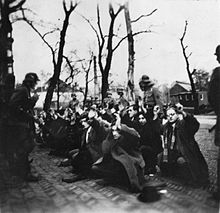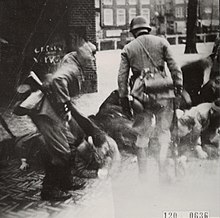February strike
You can help expand this article with text translated from the corresponding article in German. Click [show] for important translation instructions.
|


The February strike (
The direct causes were a series of arrests and
Although the February strike is considered to be the first public protest against the Nazis in
Background and cause
The Netherlands surrendered to Nazi Germany in May 1940, and the first anti-Jewish measures—the barring of Jews from the air-raid defence services—began in June 1940. In November 1940 all Jews were removed from public positions, including universities, which led directly to student protests in Leiden and elsewhere. Meanwhile, there was an increasing feeling of unrest by workers in Amsterdam, especially the workers at the shipyards in Amsterdam-Noord, who were threatened with forced labour in Germany.
As tensions rose, the Dutch Nazi party
On 12 February, German soldiers, assisted by Dutch police, encircled and cordoned the old Jewish neighbourhood from the rest of the city by putting up barbed wire, raising bridges, and setting up police checkpoints. The neighbourhood was now forbidden for non-Jews.
On 19 February, the German
Strike

After the pogrom, on 24 February, an open-air meeting was held on the Noordermarkt to organise a strike to protest against the pogrom and the forced labour to Germany. The Communist Party of the Netherlands, which was made illegal by the Germans, printed and spread a call to strike throughout the city the next morning. The first to strike were the city's tram drivers, followed by other city services as well as companies like department store De Bijenkorf and schools. Eventually 300,000 people joined in the strike, which brought much of the city to a halt and caught the Germans by surprise.[5]
The strike grew spontaneously as other workers followed the example of the tram drivers, and spread to other areas, including
In response, a curfew was declared and a German police battalion and two
The suppression was successful, and most strikers were back at work by 27 February. Although ultimately unsuccessful, the strike was significant in that it was the first and only large-scale direct action against the Nazis' treatment of Jews in Europe.
The next strikes would be student strikes in November 1941 and the so-called
The rest of
Remembrance

The strike is remembered each year on 25 February, with a march past the
See also
- Rosenstrasse protest: A successful 1943 protest against the deportation of Berlin Jews organized by their non-Jewish spouses and other family members.
- Strike of the 100,000: communist-led strike in occupied Belgium with the objective to demand a wage increase although it was also an act of passive resistance to the German occupation.
- Milk Strike: Norwegian strike in September 1941 against rationing of milk.
- 1942 Luxembourgish general strike, 31 August 1942 against a German directive that conscripted young Luxembourgers into the Wehrmacht.
Bibliography
- ISBN 90-214-6898-0.
- ISBN 90-230-0290-3.
- ISBN 90-12-04893-1.
- Manheim, Jack. Memoirs of the Dutch Underground 1940–1945 – Why me? (England: Amazon, 2017). [1] ISBN 1521902240
References
- ^ Amsterdam, USHMM
- ^ 1941: The Dutch Strike Against Nazi Abuses of Jews, Haaretz
- ^ Romijn, Peter, "The Experience of the Jews in the Netherlands During the Nazi Occupation" in Dutch Jewry: Its History and Secular Culture, 1500-2000. Leiden: Brill 2002, 260-61.
- ^ Amsterdam marks anniversary of 1941 mass strike in support of Jews, World Jewish Congress
- ^ Congress, World Jewish. "Amsterdam marks anniversary of 1941 mass strike in support of Jews".
- ^ de Jong, Dr. Loe. Het Koninkrijk der Nederlanden in de Tweede Wereldoorlog.
{{cite book}}:|work=ignored (help) - ^ Mak, Geert (2001). Amsterdam: A Brief Life of the City. Vintage Books.
- ^ Mazower (2001), p. 112
- ^ "The Righteous Among the Nations Department. Righteous Among the Nations Honored by Yad Vashem by 1 January 2010 THE NETHERLANDS - PDF Gratis download".
External links
![]() Media related to February strike at Wikimedia Commons
Media related to February strike at Wikimedia Commons
- North French miners' strike, May-June 1941
- Audio collection February strike at the International Institute of Social History
- Nizzan Zvi Cohen, “They’re taking our Jews!”: How Amsterdam’s workers protested the deportation of Dutch Jews, at Davar, 21 April 2020.
